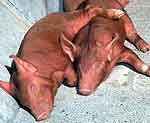Campaign to eradicate pseudorabies continues
The government is extending its campaign to eradicate pseudorabies in the United States, announcing recently that an additional $40 million has been earmarked for indemnity programs, which will continue until the funds are depleted or further notice.
 The USDA announced in the Nov 17, 1999 Federal Register that the program to depopulate infected swine herds was being continued with additional funds to compensate producers.
The USDA announced in the Nov 17, 1999 Federal Register that the program to depopulate infected swine herds was being continued with additional funds to compensate producers.
Ultimately, the goal is to eliminate pseudorabies in the United States in the year 2000.
The policy to eliminate pseudorabies in the nation began in 1989. Federal and state authorities, in cooperation with the swine industry, have worked to dramatically reduce known infected herds from 8,000 in 1992 to approximately 1,300 in 1998, which is less than one percent of US swine herds.
In 1998, however, the program suffered a setback. Depressed market conditions in the swine industry led some producers to stop vaccinating herds, a practice that has resulted in an increase in infected herds.
Responding to the threat, the USDA stepped up its efforts in January 1999 with the launch of an accelerated eradication program, which received $80 million. In addition to reimbursing owners for their animals at market value, the accelerated program covers euthanasia and disposal costs.
The accelerated program is operated in combination with the ongoing pseudorabies eradication program.
All states have virtually eliminated pseudorabies-infected herds, with the exception of Indiana, Iowa, and Minnesota, which are in the midst of substantial eradication programs.
Enhanced surveillance for pseudorabies under the accelerated program has contributed to the detection of another 550 infected herds. An estimated 200 additional infected herds are expected to be identified in 2000.